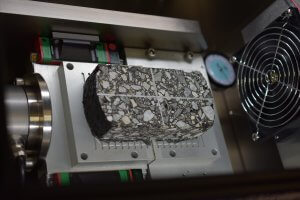From studying and monitoring roadways paved with waste-plastic infused asphalt to analyzing the regional economy and outlook for 2023, CAIT researchers have been making headlines lately for their impactful and implementable research.

CAIT researchers are studying the performance of roads paved with plastic-infused asphalt. Photo ©Rutgers Asphalt Pavement Laboratory.
Innovative Asphalt Research
Dr. Tom Bennert, CAIT researcher and Director of the Rutgers Asphalt Pavement Laboratory, was featured in the American Society of Civil Engineers’ (ASCE) “Civil Engineering Source” for his innovative work monitoring the performance of two public Staten Island roadways that were paved using an asphalt mix incorporating waste plastic.
Partnering with the New York City Department of Transportation (NYCDOT) and Scotland-based company MacRebur, sections of Rice Avenue and Royal Oak Road in Staten Island were covered with an asphalt mix containing waste plastic.
The approach is estimated to have saved more than 16,128 lb. of carbon dioxide emissions compared to traditional asphalt while keeping the equivalent of more than 214,000 plastic bottles out of the landfill, according to NYCDOT. Dr. Bennert and the Rutgers Asphalt Pavement Laboratory are now being engaged to monitor the performance of this innovative mix.
Dr. Bennert was also featured in Forbes for this project as well as in Construction Equipment Guide.
Economic Outlook for 2023
CAIT researcher and dean emeritus of the Edward J. Bloustein School of Planning and Public Policy at Rutgers, Dr. James W. Hughes was published in the February 2023 edition of NJ Municipalities Magazine, the official publication of the New Jersey State League of Municipalities.
His article, “2023: The Year of Living Dangerously,” analyzed the economic outlook for 2023 both in NJ and nationwide, while also reviewing the trends that shaped the second half of 2022.
“Structurally, pandemic-driven economic, technological, and demographic surges are starting to show trend reversion, i.e., revert to pre-pandemic trendlines,” he writes in the article. “Covid-19 was a ‘gasoline on the fire’ accelerant. It vastly increased the pace of structural change that had been already underway, such as accelerating remote work practices, accelerating the expansion of e-commerce, accelerating the bricks and mortar retail meltdown, accelerating millennial residential suburbanization (sparking the biggest suburban housing boom in more than a decade), and accelerating the pace of baby boom retirements (aggravating labor shortages). Embedded change in each of these areas was dramatically transformed into hyper change in 2020 and 2021. However, by mid-2022, the surges started to deaccelerate, returning to the pre-pandemic trendlines and patterns of change.”

